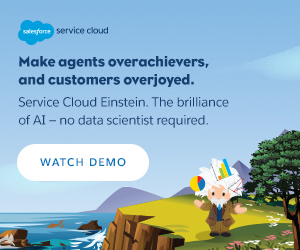This content was produced for Salesforce by the foundry @ MEREDITH CORP. FORTUNETM editorial staff was not involved in its creation or production.
Railroads did not stop growing because the need for passenger and freight transportation declined. Railroads are in trouble today because they assumed themselves to be in the railroad business rather than in the transportation business. The reason they defined their industry incorrectly was that they were railroad oriented instead of transportation oriented; they were product oriented instead of customer oriented.
If these statements sound like a timely manifesto urging a new way of thinking in the digital age, that’s because they are. Yet they were written by American economist Theodore Levitt in 1960, long before the introduction of technology such as artificial intelligence (AI), machine learning, and the Internet of things (IoT).
This serves to highlight the point that bright, shiny objects— the new technologies available to every contact center—are transforming the way companies define the customer experience. And it’s not surprising that so many companies are investing in innovative contact center tech to keep up with the ever-increasing number of channels their customers use. But true empathy and responsiveness are never artificial. These traits are still strictly human. At the same time, however, the right tools make every customer service agent’s life easier, once they learn how to use them.
This isn’t new. From the beginning of commerce, the role of the customer service agent has evolved alongside technology, starting with the telephone, which was invented in 1876. It freed customers from having to travel for product information or to get repairs. Next came telephone switchboards that allowed customers to reach businesses en masse and across many miles.
For their part, call centers—which were born in the 1960s— were later enhanced by touch-tone dialing, 1-800 numbers, and so on. The introduction of the Internet in the early 1990s caused another revolution, of course, making email and live chat possible—no phone needed. By the 2000s, firms were using customer support software and customer-relationship management (CRM) systems to boost service to loftier heights. Suffice to say, today’s customer service organizations are using AI, predictive analytics, chatbots, social medial, and omnichannel communications to surpass customer expectations.
All this means that service agents must work across multiple platforms and leverage new technology to engage and connect with customers. The good news is that they are uniquely placed to skill up and take advantage of these new technologies—and there is plenty of help at hand for them to do so. And with the rise of AI, the role of service agents will only continue to develop.
Blazing a Trail
Successful firms recognize that digital transformation is IOne organization that has developed a curriculum for contact center agents and supervisors is Salesforce, the company that made its mark with CRM software. Through its Trailhead initiative, Salesforce has produced a series of free online tutorials designed to future-proof the skills and talents of contact center agents. The jargon-free series is for everyone—from agents to leadership. Some of it addresses soft skills. Other modules take a deep dive into technology. But they are all written for the layperson.
Tutorials, such as the ones listed here that Trailhead offers, can cover a range of topics, including:
● Artificial intelligence (AI): Courses on machine learning typically cover natural language understanding and processing, how data becomes algorithms, and how certain AI products empower agents with predictive intelligence. In straightforward language, Trailhead’s unit introduces the Einstein series of tools and explains how these tools can resolve customer issues, collect customer information, and drive agent productivity. It explains that there are also Einstein products that complement field service, deliver predictive service KPIs, and can classify text by sentiment.
● Chatbots: This unit shows how chatbots can quickly resolve common customer issues, collect and qualify customer information, reduce chat duration, and be trained to understand human language. It also provides setup advice.
● Mastering the art of customer service: This section delves into the value of active listening, critical thinking, and emotional intelligence in the contact center. It also identifies practical ways to use active listening, critical thinking, and emotional intelligence while engaging with customers.
● Managing dissatisfied customers: This unit introduces managers to the concept of the communication chain, which stresses that every verbally expressed concern requires a response. It also teaches how to deescalate tense exchanges over the entire range of channels, while taking into account the subtle differences in each one.
At the end of the day, it is still vital for human agents to understand the promise and limitations inherent to these tools, in order to use them to inform customer service in the bestpossible way.
But investing in upskilling agents pays for itself almost immediately. The reason: The best agents are already embracing this opportunity for training and skill-building. They recognize how much they personally stand to gain by learning how emerging technologies work and how these technologies can help them excel at their jobs. Feeling empowered by new learning and growth opportunities, they develop a greater sense of initiative, loyalty, and long-term commitment to the company.
Finally, they appreciate that their jobs are secure. Customer service will always depend on humans to deliver the empathy, intuition, and care that consumers expect.







